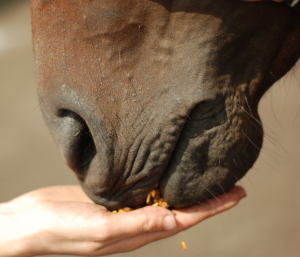Does My Horse Need a Diet or Exercise Change?

During an Equine Nutrition class, a student requested an evaluation of her horse to determine if any diet or exercise changes were necessary. This case highlighted the importance of assessing a horse’s body condition, weight, and topline when considering adjustments to their diet or exercise regimen.
The Horse Evaluation
Appearance versus Muscle Coverage
The evaluated horse was a 4-year-old Warmblood gelding, measuring 17.1 hands and weighing 1350 pounds. At first glance, the horse appeared to be in good flesh, but upon closer examination, a lack of muscle and coverage in the withers and back areas was noticeable.
Current Diet and Potential Issues
The student shared that the horse’s current diet consisted of 20 pounds of first cutting hay per day and 8 pounds of locally grown oats. While the calorie content seemed sufficient, there was a deficiency in the amino acid balance. The student also mentioned recent saddle refitting and chiropractic visits due to the horse’s back issues.
Identifying the Need for Changes
Increased Workload and Nutritional Requirements
Considering the horse’s increased workload due to the transition to college, it was evident that additional fortification was necessary. A ration balancer was recommended to address the young horse’s dietary needs and help replenish his topline.
Challenge and Counterargument
During the evaluation, another student challenged the recommended dietary change. As an Equine Physiology major, she believed that working the horse in a more collected manner, engaging the hindquarters and developing the topline through exercise, would be sufficient. She perceived the horse as overweight and did not see the need for a diet change.
Understanding the Importance of Proper Nutrition
Comparing Diet Deficiencies
To explain the importance of proper nutrition, an analogy was drawn to a young child on a diet consisting solely of rice. Such a diet lacks essential amino acids, resulting in a rounded abdomen but a lack of muscle mass. In this scenario, simply increasing exercise would not lead to muscle development unless the diet is appropriately supplemented.
Listening to Your Horse
The horse’s physical condition and performance can serve as indicators of dietary deficiencies. Taking the time to observe and assess your horse’s body condition, weight, and muscle development can provide valuable insights into whether diet or exercise changes are necessary.
When considering diet or exercise changes for your horse, it is crucial to evaluate their body condition, weight, and topline. Deficiencies in amino acids or other essential nutrients can affect muscle development and overall health. By paying attention to your horse’s physical cues and seeking professional advice, you can make informed decisions to ensure your horse receives the appropriate nutrition and exercise for optimal well-being and performance.
Ready to ensure your horse is getting the optimum nutrition at feeding time, every time? Find the perfect feed formulated specifically for horse’s needs with our Feed Selector Tool.
